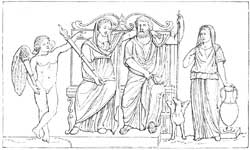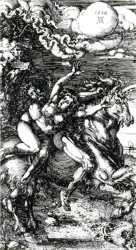Persephone
In Latin Proserpina, the daughter of Zeus and Demeter.1 Her name is commonly derived from φερειν φόνον (pherein phonon), "to bring" or "cause death," and the form Persephone occurs first in Hesiod,2 the Homeric form being Persephoneia. But besides these forms of the name, we also find Persephassa, Phersephassa, Persephatta, Phersephatta, Pherrephassa, Pherephatta, and Phersephoneia, for which various etymologies have been proposed. The Latin Proserpina, which is probably only a corruption of the Greek, was erroneously derived by the Romans from proserpere, "to shoot forth."3
Being the infernal goddess of death, she is also called a daughter of Zeus and Styx;4 in Arcadia she was worshiped under the name of Despoena and was called a daughter of Poseidon Hippius and Demeter, and said to have been brought up by the Titan Anytus.5 Homer describes her as the wife of Hades, and the formidable, venerable, and majestic queen of the Shades, who exercises her power, and carries into effect the curses of men upon the souls of the dead, along with her husband.6 Hence she is called by later writers Juno Inferna, Averna, and Stygia,7 and the Erinyes are said to have been daughters of her by Pluto.8 Groves sacred to her are said by Homer to be in the western extremity of the earth, on the frontiers of the lower world, which is itself called the house of Persephone.9
The story of her being carried off by Hades [Pluto], against her will, is not mentioned by Homer, who simply describes her as his wife and queen; and her abduction is first mentioned by Hesiod.10 Zeus, it is said, advised Hades, who was in love with the beautiful Persephone, to carry her off, as her mother, Demeter, was not likely to allow her daughter to go down to the underworld.11 Hades accordingly carried her off while she was gathering flowers with Artemis and Athena.12
Demeter, when she found her daughter had disappeared, searched for her all over the earth with torches, until at length she discovered the place of her abode. Her anger at the abduction obliged Zeus to request Hades to send Persephone (or Kore, i.e. the maiden or daughter) back. Hades indeed complied with the request, but first gave her a kernel of a pomegranate to eat, whereby she became doomed to the lower world, and an agreement was made that Persephone should spend one third (later writers say one half) of every year in the underworld with Hades, and the remaining two thirds with the gods above.13
The place where Persephone was said to have been carried off, is different in the various local traditions. The Sicilians, among whom her worship was probably introduced by the Corinthian and Megarian colonists, believed that Hades found her in the meadows near Enna, and that the well Cyane arose on the spot where he descended with her into the lower world.14 The Cretans thought that their own island had been the scene of the rape,15 and the Eleusinians mentioned the Nysaean plain in Boeotia, and said that Persephone had descended with Hades into the lower world at the entrance of the western Oceanus. Later accounts place the rape in Attica, near Athens16 or at Erineos near Eleusis,17 or in the neighborhood of Lerna.18

The story according to which Persephone spent one part of the year in the lower world, and another with the gods above, made her, even with the ancients, the symbol of vegetation which shoots forth in spring, and the power of which withdraws into the earth at other seasons of the year.19 Hence Plutarch identifies her with spring, and Cicero20 calls her the seed of the fruits of the field.21 In the mysteries of Eleusis, the return of Kore from the lower world was regarded as the symbol of immortality, and hence she was frequently represented on sarcophagi. In the mystical theories of the Orphics, and what are called the Platonists, Kore is described as the all-pervading goddess of nature, who both produces and destroys every thing,22 and she is therefore mentioned along, or identified with, other mystic divinities, such as Isis, Rhea, Gaea, Hestia, Pandora, Artemis, Hecate.23 This mystic Persephone is further said to have become by Zeus the mother of Dionysus, Iacchus, Zagreus or Sabazius.24
The surnames which are given to her by the poets, refer to her character as queen of the lower world and of the dead, or to her symbolic meaning which we have pointed out above. She was commonly worshiped along with Demeter, and with the same mysteries, as for example, with Demeter Cabeiria in Boeotia.25 Her worship further is mentioned at Thebes, which Zeus is said to have given to her as an acknowledgment for a favor she had bestowed on him:26 in like manner Sicily was said to have been given to her at her wedding,27 and two festivals were celebrated in her honor in the island, the one at the time of sowing, and the other at the time of harvest.28
The Eleusinian mysteries belonged to Demeter and Kore in common, and to her alone were dedicated the mysteries celebrated at Athens in the month of Anthesterion.29
Temples of Persephone are mentioned at Corinth, Megara, Sparta, and at Locri in the south of Italy.30
❧
The word rape in this sense means the carrying off a woman by force; from Latin rapere, "seize."
Iconography
In works of art Persephone is seen very frequently: she bears the grave and severe character of an infernal Juno, or she appears as a mystical divinity with a scepter and a little box, but she was mostly represented in the act of being carried off by Pluto.31 Persephone appears on an Eleusinian relief in the company of Demeter and Triptolemus (second half of the fifth century BCE) where she is represented as a young woman carrying a torch. Her abduction by Hades is occasionally depicted on vases, murals, and mosaic. Usually she is depicted as the queen of the underworld: a solemn woman with scepter and diadem, ears of corn, pomegranate, torch or poppy. As such she appears on frescoes in Etruscan graves, among which the Tomba del Orco (second century BCE) at Tarquinia. Here, she is seated on a throne next to Hades, robed and bejeweled, and with snakes in her hair. A fresco at Naples, originally from Pompeii, portrays her veiled and holding a basket with fruits.
References
Notes
- Homer. Iliad xiv, 326, Odyssey xii, 216; Hesiod. Theogony, 912 ff.; Pseudo-Apollodorus. The Library i, 5.1.
- Theogony, 913; comp. Homer. Hymn to Demeter, 56.
- Cicero. On the Nature of the Gods ii, 26.
- Pseudo-Apollodorus. The Library i, 3.1.
- Pausanias. Description of Greece viii, 37.3, 6, 25.5.
- Homer. Odyssey x, 494; xii, 226, 385, 634; Iliad ix, 457, 569; comp. Pseudo-Apollodorus. The Library i, 9.15.
- Virgil. Aeneid vi, 138; Ovid. Metamorphoses xiv, 114.
- Orphic Hymn 29.6; 6; 70, 3.
- Odyssey x, 491, 509.
- Theogony, 914.
- Comp. Hyginus. Fabulae, 146.
- Comp. Diodorus Siculus, v, 3.
- Pseudo-Apollodorus. The Library i, 5. 1 ff.; Ovid. Metamorphoses v, 565.
- Diodorus Siculus, v, 3 ff.; comp. Ioannes Lydus. De Mensibus, 286; Ovid. Fasti iv, 422.
- Scholiast on Hesiod's Theogony, 913.
- Scholiast on Sophocles' Oedipus Colonus, 1590.
- Pausanias. Description of Greece i, 38.5.
- ibid. ii, 36.7; respecting other localities see Conon. Narratives, 15; Orphic. Argonautica, 1192; Spanheim, on Callimachus' Hymn to Demeter, 9.
- Scholiast on Theocritus, iii, 48.
- Cicero. On the Nature of the Gods ii, 26.
- Comp. Ioannes Lydus. De Mensibus, pp. 90, 284; Porphyry. On the Cave of the Nymphs, p. 118 (ed. Barnes).
- Orphic Hymn 29, 16.
- Tzetzes on Lycophron, 708, 1176; Scholiast on Apollonius Rhodius, iii, 467; Scholiast on Theocritus, ii, 12; Servius on Virgil's Aeneid iv, 609.
- Hesychius, s.v. Zagreus; Scholiast on Euripides' Orestes, 952; Aristophanes. The Frogs, 326; Diodorus Siculus, iv, 4; Arrian. Expedition of Alexander the Great ii, 16; Ioannes Lydus. De Mensibus, p. 198; Cicero. On the Nature of the Gods iii, 23.
- Pausanias. Description of Greece ix, 25.5.
- Scholiast on Euripides' Phoenician Women, 687.
- Pindar. Nemean Odes, i, 17; Diodorus Siculus, v.2; Scholiast on Theocritus, xv, 14.
- Diodorus Siculus, v, 4; Athenaeus, iv, p. 647.
- Comp. Pausanias. Description of Greece i, 31.1 ff.
- Pausanias. Description of Greece iii, 13.2; Livy. History of Rome xxix, 8, 18; Appian, iii, 12.
- Pausanias. Description of Greece viii, 37.2.
Sources
- Aken, Dr. A.R.A. van. (1961). Elseviers Mythologische Encyclopedie. Amsterdam: Elsevier.
- Hirt, A. Mythologischer Bilderbuch i, p. 72 ff.
- Smith, William. (1870). Dictionary of Greek and Roman Biography and Mythology. London: Taylor, Walton, and Maberly.
- Welcker. Zeitschrift fur die alte Kunst, p. 20 ff.
This article incorporates text from Dictionary of Greek and Roman Biography and Mythology (1870) by William Smith, which is in the public domain.
